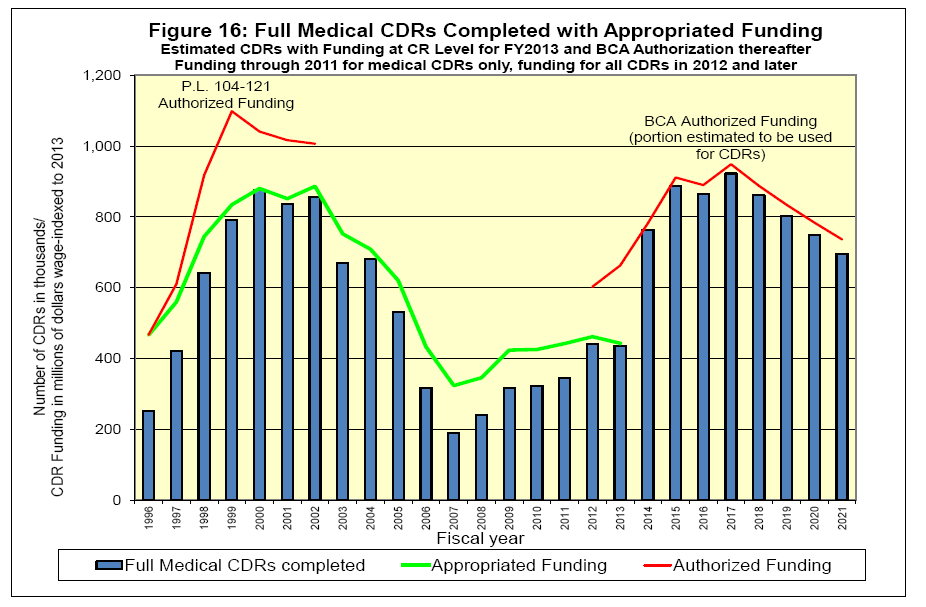AUCD Response to 60 Minutes Story on SSDI
October 8, 2013
Recently, media have been reporting on the Social Security Disability Insurance program, including growth in the program. While they raise concerns about the program, the reality is much more complex. AUCD encourages media to investigate the many facets of the challenges affecting the program, including Congress' reluctance to provide adequate funding for program integrity, reforms proposed by the disability community to help people with disabilities return to work, and why Congress is suddenly treating the Disability Insurance trust fund differently.
Program Integrity
We agree that any abuse of the program is wrong and should be weeded out. However, the Social Security Administration's critical program integrity work is stymied by insufficient resources.
Insufficient funding for initial disability reviews means that more cases will end up at the hearing level when cases have been denied due to incomplete development of the record, leading to delays in decision-making and great hardship for deserving claimants.
Adequate resources support claims processing and disability determinations at the initial levels so that the correct decision can be made at the earliest point possible and unnecessary appeals can be avoided. Inadequate staffing at field offices and state Disability Determination Services (DDS) leads to increased workload at the hearing level. Disability claims may be less thoroughly developed, leading to incorrect denials of benefits and more appeals. Information is emerging from across the country involving a marked increase in the denials of claims to individuals who are otherwise clearly eligible, forcing individuals and families to seek legal counsel to insure they or their loved one receives a fair determination process. This is appears to be an often unnecessary and burdensome cost that in the past was unnecessary due to the resource availability in determinations being adequate to the need. Reporters should be talking to these individuals and families to better understand the costs and tolls they experience as result of these circumstances. Additionally, the significant progress made in recent years at the hearing level in reducing average wait times until hearings and shrinking the disability claims backlog, will be eroded due to the lack of needed resources.
![]()

The Social Security Administration has intensive program integrity efforts including continuing disability reviews (CDRs) and redeterminations of benefit eligibility. The Social Security Advisory Board estimates that CDRs save $10 in benefits for every $1 spent on reviews, but funding appropriated by Congress for reviews fell sharply between 2002-2007 and has only recently risen modestly. In 2012, Congress appropriated $140 million less for SSA program integrity than was authorized by the Budget Control Act of 2011. There is a current backlog of 1.3 million CDRs due to insufficient funding. Reporters should investigate why Congress has not appropriated the necessary funds to address the backlog.
Rehabilitation and Return-to-Work
According to the National Council on Disability, Social Security disability benefits are the "last stop on a long journey" that includes stops at uncoordinated disability and employment services like vocational rehabilitation, transition services from high school to work, other workforce investment programs and Temporary Aid to Needy Families. The Senate Health, Education, Labor and Pensions committee has passed bipartisan legislation to reauthorize the Workforce Investment Act improve coordination of disability services, including encouraging youth with disabilities to transition into employment after high school graduation. The House has also passed legislation to reauthorize the Workforce Investment Act, but it would consolidate or eliminate many of these programs. Reporters should ask Congress why they have not yet voted to improve these programs, or even voted to eliminate them.
The Personal Responsibility and Work Opportunity Reconciliation Act of 1996 implemented time limits and work requirements on benefits - requirements which place particular burden on people with disabilities and increase likelihood they will apply for disability benefits rather than seek re-employment services. The disability community has called for bipartisan policies that will facilitate greater connection between welfare recipients and rehabilitative services to help people with disabilities return to work. These reforms have not been implemented.
Some Members of Congress working on the 1996 welfare reform recognized that additional supports would be needed for those hardest to serve, such as individuals with disabilities or those families supporting children with disabilities. For example, the "Tripartisan Agreement" created by Senators Hatch, Breaux, Jeffords, and Rockefeller to reauthorize TANF in 2002 would have increased work expectations but expanded those work requirements to include rehabilitative employment services that help people with disabilities return to work. A similar bill, the Personal Responsibility and Individual Development for Everyone (PRIDE) Act, received bipartisan support in the Senate Finance Committee in 2005. Both proposals had strong support from the disability community but were not included in the reauthorization of TANF in 2005. Reports about the "new welfare" should investigate why Congress has not approved programs intended to facilitate individuals with disabilities ability to engage in meaningful employment or opportunities to return to work whenever possible.
Disability Insurance Trust Fund
The Social Security Disability Trust Fund (DI) is by law separate from the fund for Old Age and Survivors Insurance Fund (OASI), but routine reallocations between the funds have occurred frequently and in both directions throughout the history of the programs. Reallocations are so common that most budget experts discuss solvency of the funds together as "OASDI", including the Bipartisan Policy Center Domenici Rivlin Task Force, the Social Security Trustees, Center on Budget and Policy Priorities, and Committee for a Responsible Federal Budget. Taken together, the trust funds will not be exhausted until 2033. One might ask why SSDI is being "singled out" in these media reports as, historically, programs for individuals with disabilities have historically been underfunded. Congress must reallocate between the programs as it has traditionally done, and reports should investigate why they have not yet taken this traditional and non-controversial action, to avoid exhausting the DI trust fund in 2016.
For more information contact Rachel Patterson, Policy Analyst at AUCD and member of the Consoritum for Citizens with Disabilities Social Security Task Force







